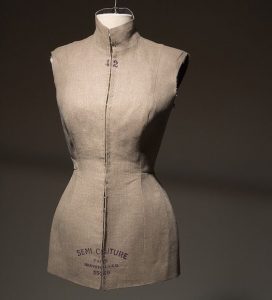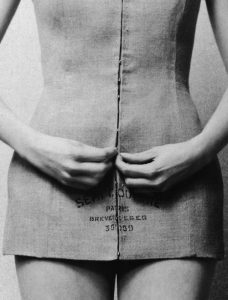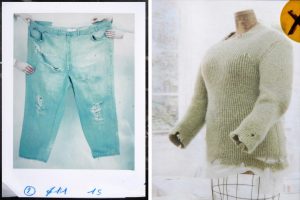Maison Martin Margiela – Fall 1997 Seimi Couture Dress Form Tunic
The exhibition at FIT Museum showcases a series of garments that explore the relationship between fashion and our physical bodies. Throughout the time, fashion designers have been trying to change or emphasize certain parts of our bodies to build an image of fashion. For instance, “The New Look” from 1940s Dior expressed high-class elegance and femininity through small waist and voluminous skirt; Chanel’s innovated dress suit featured straight fit jacket and pencil skirt which embodied females with independence; in the 90s, Comme des Garcons presented a collection called “Dress Meets Body, Body Meets Dress”, challenging the conventional image of body by deforming the fitted dress with huge stuffed paddings.
Among designers’ different takes on fashion and body, the 1997 Dress Form Tunic from Martin Margiela interests me the most. By recreating the dress form’s shape and design into a garment, Margiela is trying to express the artificial factor of how an ideal body type in fashion is. His ironic anti-perfect action reminds me of his unique runway show for Fall/Winter 2000, “The show felt new because of the revolutionary techniques Martin used and the fact that we were showing XXXL sizes at a time when the trend was about a slim silhouette and low-waisted skinny pants”, as Vicky Roditis, Sales Manager and “Ambassadrice” to Martin Margiela remembered (Woo, “7 Martin Margiela Fans and Collaborators Remember His Most Radical Show”, The New York Times).
In my own design practices, I never really use tight-fitted shapes to pursue the ideal slim body image. On the contrary, I tend to use oversized or structural silhouettes to accommodate the body. This is to consider body as the land and fashion’s purpose is to construct shapes and build texture on it, not to focus on the perfect body image itself.


